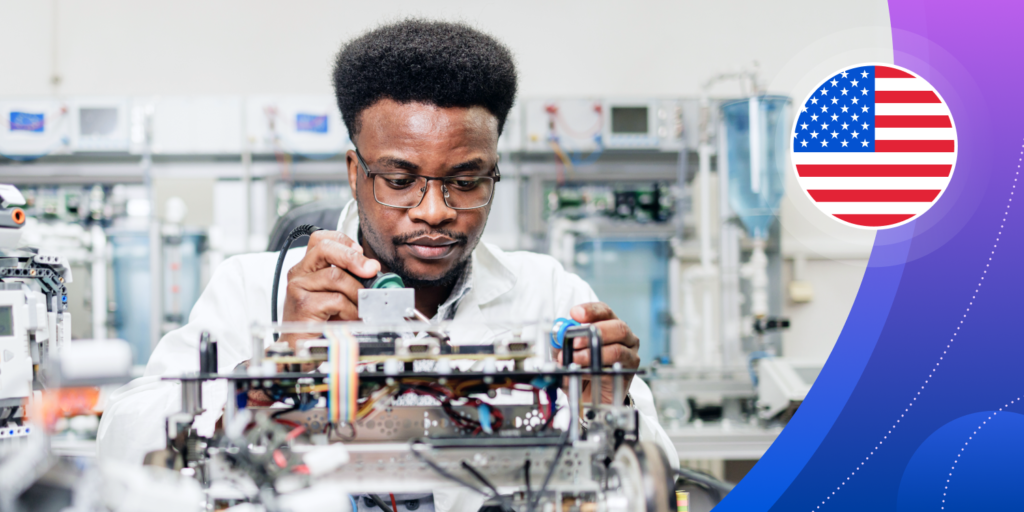Are you thinking about becoming an international student in the United States? If so, you’ll join an international student population that comes to the US from over 200 places of origin. Many students will balance their studies with a part-time job, co-op, or internship. However, the rules around working while studying in the US can be stricter than in some other study destinations.
Depending on your student visa classification, program, and how far into your program you are, your opportunities to work in the US as an international student will vary. To help you find a good work-study balance that won’t risk your student visa, we’ll look at your options for working in the US while studying, and how you can get work experience after you graduate.
Note: This post is not meant as official immigration or residency advice. For the most up-to-date information, please visit the official U.S. Citizenship and Immigration Services (USCIS) website. If you’re interested in learning about ways to stay in the US after completing your degree, contact an American immigration attorney.
Thinking about studying in the US? Consider attending one of these top-ranked US universities.
Working While Studying in the US
Before you apply, ensure that the college or university you apply to is authorized by the American government to accept international students. International students usually enter the US on an F-1 visa (academic student visa), but may also enter on a J-1 or M-1 visa. For both F-1 and M-1 visas, students must be enrolled in full-time studies, which means new students will largely be limited to working part-time hours.
F-1 students may work on-campus:
- Up to 20 hours per week during regular full-time semesters
- Up to 40 hours per week during scheduled breaks, like winter and summer holidays
During the first year of studies, F-1 visa students may not work off-campus.
After the first academic year ends, F-1 students may continue to work on-campus and may become eligible for two types of off-campus work:
- Curricular Practical Training (CPT)
- Optional Practical Training (OPT)
Whether it’s CPT or OPT, F-1 students’ off-campus work must relate to their field of study. Before starting either, the training must be authorized by USCIS and the academic institution’s Designated School Official.
Working isn’t the only way to pay for tuition—these scholarships for international students in the US can help, too.
How Does CPT Work?
As you might guess from its full name (Curricular Practical Training), CPT is built into some programs’ curriculum. If CPT is part of your program, it’s mandatory and must be finished before graduation. In many cases, you’ll earn course credit for CPT.
CPT can have a few different formats:
- Co-operative education program (co-op)
- Internship (paid or unpaid)
- Practicum
Plus, because it’s part of your study program, CPT is not restricted to the 20-hour work limit that OPT or on-campus work are. However, if you complete one year of full-time CPT, you won’t be eligible for OPT, so plan your training carefully.
How Does OPT Work?
If you find employment in your field, you have the right to exercise Optional Practical Training (OPT) for up to 12 months. You can use OPT during your studies, after finishing your program, or a combination of the two. This means you can work in the United States for a limited and specific time without a new visa.
Any time spent on OPT while studying counts toward the 12-month allowance, but you can still only work up to 20 hours per week when class is in session. You may work full-time (40 hours/week) when your program is on a scheduled break. If you use all your OPT time while studying, you can’t do any post-graduation OPT.
Did you study a program on the STEM Designated Degree Program List? You might be eligible for a 24-month extension to your post-graduation OPT allowance. Check the USCIS STEM OPT page for more details.
Learn more about CPT, OPT, and work-integrated learning opportunities in the US.
Applying for Work Visas
If you secure OPT employment after finishing your certification, the company you’re working for while you hold an F-1 student visa has the option to apply for an H-1B visa (Specialty Occupations visa) on your behalf, provided it is eligible to do so. They may do this during your OPT or after it ends. The H-1B is a visa for new foreign workers with a bachelor’s degree or higher.
There’s a yearly cap of 65,000 H-1B visas issued, and 20,000 more are available to grads with a master’s degree (or higher) from a US academic institution. However, the number of applicants is always higher than the cap. In total, 479,953 H-1B applications were submitted for the 2025 fiscal year (July 1, 2024 to June 30, 2025).
If you receive an H-1B visa, you may live and work in the US for up to three years. This time may be extended, but usually can’t be longer than six years. If you plan to work in the US, and would like your direct family to join you, H-1B visa holders’ spouses and unmarried children may be eligible for an H-4 dependent nonimmigrant visa.
If you’re an F-1 student visa holder and have filed an H-1B petition and change-of-status request, but your F-1 status will end before your status change, you may be able to get a cap-gap extension.
To compare work-study balance across the pond, here’s a look at work guidelines for international students in the United Kingdom.

We hope this information on studying and working in the US is helpful. Best of luck as you plan your journey as an international student!
Ready to take the next step? Register for free with ApplyBoard to find programs in the US which fit your academic goals and budget.



